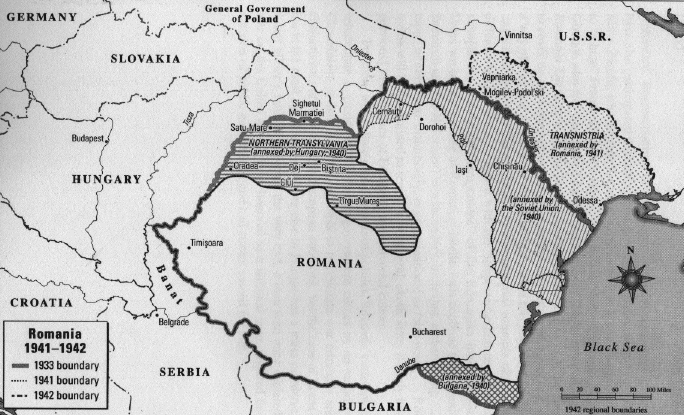


V. Transnistria:
Place of Suffering and Death
On the 19th of August 1941, at
Tighina, a Pact between Germany and Romania was
concluded, according to which, the territory between the
rivers Dnestr and Bug was put under Romanian authority.
Consequently, on the 17th of October 1941, the Romanian
government officially proclaimed the Province
"Transnistria", with Odessa as its capital
city.
The traced boundaries of this
territory started from Nicolaev on the Black Sea, along
the Bug, passing through Voznesensc, Konstantinovka,
Govoron and Bar until Moghilev at the Dnestr, with an
area of 41,400 square km. (nearly as the Romanian
provinces Oltenia and Banat together), having a
population of 2,2 million, mostly Ukrainians and
Russians. 1)
It is to be mentioned that
before the war over 200,000 Romanians and about 300,000
Jews lived in Transnistria. (Transnistria from the year
1941 is not to be confounded with the present day
Transnistria, component of the Republic Moldavia, which
includes a narrow strip of land along the Dnestr, from
Tiraspol to Rabnita).
From an administrative point of
view, Transnistria included 13 districts:
• In the north the
districts: Moghilev, Tulcin, Iugastru,
• In the center the
districts: Balta, Golta, Ananiev, Dubasari,
Rabnita,
• In the south the
districts: Berezovka, Tiraspol, Ovidiopol, Oceacov,
Odessa.
In order to ethnically purify
Romania, the Antonescu government decided that
Transnistria had to be the deportation place for the
Romanian Jews.
Based on a deliberated and well
organized program, this province was transformed into an
immense camp, destined to exterminate tens of thousands
of Jews.
Prof. Gh. Alexianu, named as
governor of Transnistria, applied precisely this
policy.
The Jews deported from Romania
were settled in compact masses, being forced to live in
ghettos, labor- colonies and labor camps, situated in the
districts Moghilev, Balta, Tulcin and Golta
The biggest ghettos were
constituted in the localities Moghilev, Lucinet,
Copaigorod, Murafa, Sargorod, Djurin Obodovca, Bersad,
Nesterovka and others.
The authorities did not assure
even the most elementary conditions of life and survival.
The majority of the deportees suffered from starvation,
cold and illness, being crowded besides the local Jews,
in dwellings that couldn't accommodate all deportees. In
some small rooms dwelt 8-10 persons. Others found shelter
in synagogues, various sheds, huts, pigsties and other
improvised places.
To be able to provide some food,
the majority of the Jews sold to the Ukrainians the last
belongings that they had. Many of them became beggars,
and others fed on potato skins and other domestic
rests.
The winter in 1941 was hard. The
very low temperatures, the inhuman living conditions,
famine and illnesses made thousands of victims mainly
among children and old people. The corpses were gathered
and thrown into common graves, so that the descendants
would never know their graves.
Due to the misery reigning in
the ghettos a terrible typhus epidemic broke out, that
made numerous victims. In the fight to struggle against
the epidemic many Jewish doctors on duty,
died.
Many families completely
disappeared. The majority of the families paid a heavy
blood tribute.
1)
See, Schechtman Iosif: "Transnistra," Revista
Cultului Mozaic, No. 766, Sept. 1993